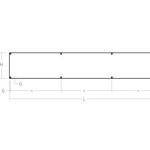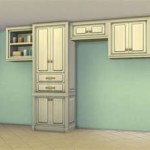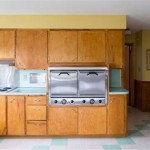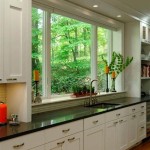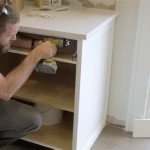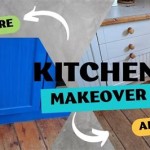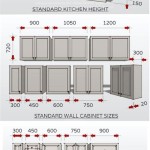Can You Change Doors on Kitchen Cabinets Without Removing Them?
Kitchen cabinet doors significantly contribute to the overall aesthetic of a kitchen. Over time, these doors may become outdated, damaged, or simply no longer align with evolving design preferences. A common question that arises during kitchen renovations is whether it's possible to replace cabinet doors without undergoing the more extensive process of removing the entire cabinet box.
The short answer is yes, it is often possible to change doors on kitchen cabinets without removing the cabinets themselves. However, the feasibility and success of this approach depend on several factors, including the cabinet construction, hinge type, and desired aesthetic outcome. This article examines the different aspects of replacing cabinet doors without removing the cabinet boxes, outlining considerations and potential challenges.
Assessing Cabinet Box Condition and Compatibility
Before embarking on a cabinet door replacement project, a thorough assessment of the existing cabinet boxes is crucial. The integrity of the cabinet box directly impacts the suitability of simply replacing the doors. Key areas to inspect include:
Structural Stability: The cabinet boxes must be structurally sound to support new doors. Check for signs of warping, water damage, or separation at the joints. If the cabinet boxes are significantly damaged, replacing the doors without addressing the underlying issues will likely lead to further problems and may not be a worthwhile investment.
Squareness and Alignment: Ensure the cabinet boxes are square and properly aligned. Doors attached to misaligned boxes will not sit flush and can create an uneven and unprofessional appearance. Minor adjustments may be possible, but severely out-of-square cabinets may necessitate more extensive repairs or replacement.
Hinge Compatibility: Evaluate the existing hinge type and its compatibility with the new cabinet doors. Different hinge types require different mounting configurations. If the new doors require a different hinge type, ensure that the cabinet boxes can accommodate the necessary modifications without compromising their structural integrity.
If the cabinet boxes are in good condition and compatible with the desired door style and hinge type, replacing the doors without removing the cabinets is a viable option. However, if significant repairs or modifications are required, it may be more practical to consider a complete cabinet replacement.
Measuring and Ordering New Cabinet Doors
Accurate measurements are imperative for a successful cabinet door replacement project. Precise measurements ensure that the new doors fit correctly and operate smoothly. Several measurements are required to ensure proper fit and function.
Door Size: Measure the height and width of the existing doors, taking these measurements from the back of the door rather than the front. Consistency is important. Measure all doors, even if they appear to be the same size, as slight variations can occur. If the doors overlap the cabinet opening (overlay doors), this overlap must be considered in the measurements.
Hinge Placement: Precisely measure the location of the existing hinges on both the door and the cabinet box. This information is crucial for ensuring the new doors are drilled with the correct hinge placement. Incorrect hinge placement will result in misaligned doors that do not close properly.
Door Thickness: Note the thickness of the existing doors. While slight variations in thickness may be acceptable, significant differences can affect hinge functionality and the overall appearance of the cabinets.
When ordering new doors, provide the supplier with all of the measured dimensions and hinge specifications. Clarify whether the measurements are for the door size only or include any overlay. It's often helpful to provide photographs of the existing cabinets and hinges to ensure accurate replication.
Considering material selection is also critical. Common materials for cabinet doors include wood, MDF (Medium-Density Fiberboard), and thermofoil. Wood doors offer a classic aesthetic and can be easily refinished, while MDF doors are more resistant to warping and cracking. Thermofoil doors are a cost-effective option that offers a smooth, easy-to-clean surface. The best material depends on budget, desired aesthetic, and intended use.
Installing New Cabinet Doors Efficiently
The installation process itself requires attention to detail to achieve a professional-looking result. Careful alignment and secure attachment are essential for ensuring that the new doors function smoothly and aesthetically.
Hinge Installation: Begin by attaching the hinges to the new cabinet doors. Ensure the hinges are properly aligned and securely fastened. Use a drill or screwdriver to tighten the screws, avoiding over-tightening, which can strip the screw holes. Pre-drilling pilot holes can prevent splitting of the wood or MDF.
Door Alignment: With the hinges attached to the doors, carefully align each door with the corresponding cabinet box. Use shims or strategically placed cardboard to temporarily hold the door in place while attaching the hinges to the cabinet box. Ensure the door is level and evenly spaced before securing the screws.
Adjustments: Once the doors are installed, check their alignment and functionality. Most hinges offer some degree of adjustment, allowing for fine-tuning of the door's position. Use a screwdriver to adjust the hinge screws until the door is perfectly aligned and closes smoothly. Pay particular attention to the gap between the doors and the cabinet boxes, and adjust as needed to achieve a consistent and professional appearance.
Hardware Installation: Install any desired door pulls, knobs, or handles. Mark the desired location for the hardware and drill pilot holes. Securely attach the hardware using appropriate screws, ensuring they are tightened adequately but not over-tightened.
Replacing cabinet doors without removing the cabinet boxes can be a cost-effective and time-saving way to update the kitchen. However, careful planning, accurate measurements, and attention to detail are crucial for success. If the cabinet boxes are in poor condition or require significant modifications, a full cabinet replacement may be a more prudent investment.
When replacing cabinet doors, consider the following:
Overlay vs. Inset Doors: Overlay doors cover part of the cabinet frame, while inset doors fit flush within the frame. The chosen style affects the required measurements and installation process. Overlay doors are generally easier to install and allow for more forgiveness with slight measurement errors. Inset doors require much greater precision in measurements and installation.
Soft-Close Hinges: Upgrading to soft-close hinges can significantly enhance the functionality of the cabinets. These hinges prevent the doors from slamming shut, reducing noise and wear and tear. Soft-close hinges may require different mounting configurations, so it is essential to ensure compatibility with the cabinet boxes.
Filler Pieces: Filler pieces are used to fill gaps between cabinets or between cabinets and walls. When replacing cabinet doors, it is important to ensure that existing filler pieces are properly aligned and securely attached. If necessary, new filler pieces can be installed to match the new doors and create a seamless appearance.
The success of replacing doors without removing the cabinets depends heavily on accurate measurements and the condition of the existing cabinet boxes. It is often advisable to consult with a professional cabinet maker or installer, especially if the project involves complex modifications or non-standard cabinet configurations. A professional can provide expert advice and ensure that the project is completed successfully.
Ultimately, replacing cabinet doors without removing the cabinets is a viable option for many kitchen renovation projects. By carefully assessing the cabinet boxes, taking accurate measurements, and following proper installation techniques, it is possible to achieve a significantly updated kitchen aesthetic without the expense and disruption of a full cabinet replacement. While potential challenges may arise, careful planning and attention to detail can help ensure a successful outcome.

New Cabinet Doors Reface Kitchen Cabinets Makeover Diy

Can You Replace Kitchen Cabinet Doors Only Know This First

Reface Or Replace Your Kitchen Units Dream Doors

Reface Or Replace Your Kitchen Units Dream Doors

10 Simple Ideas To Update Your Kitchen Cabinets Jenna Sue Design

How Can I Change The Look Of My Kitchen Cabinet Doors Now

Transform Your Space How To Change Cabinet Doors Like Pro

98 Don T Know This Easy Kitchen

10 Simple Ideas To Update Your Kitchen Cabinets Jenna Sue Design

How To Reverse Cabinet Doors For A Free Diy Kitchen Upgrade
Related Posts

